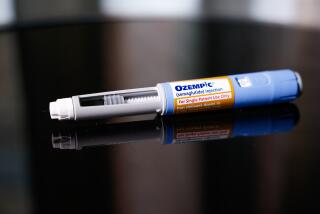Drug Industry Vision: Faster and Cheaper
- Share via
When drug industry pioneer Alejandro Zaffaroni looks at the world’s great pharmaceutical houses, he sees a bunch of companies that look uncannily like the Swiss watch industry just before the Japanese mass-produced time on quartz and silicon.
“Instead of one Swiss craftsman making one beautiful chronograph a year,” says the soft-spoken Zaffaroni, “you now have the Japanese digital watch market where the per-unit costs are but a fraction of the Swiss.”
By the decade’s end, he quietly predicts, emerging technology will similarly transform pharmaceuticals. The economics of drug development will rival the economics of silicon electronics: cheaper, better and faster.
Zaffaroni’s vision totally rejects the big-budget conventional wisdoms of pharmaceutical innovation. The industry-funded Center for the Study of Drug Development at Tufts University asserts that development of a new drug takes an average of 12 years and costs more than $230 million--more than double the costs of a decade ago. The high cost of drug development has enabled the pharmaceutical industry to win special intellectual property protections and the government-sanctioned monopoly of the Orphan Drug Act.
But with the technologies now coming to market, “There can be at least an order of magnitude difference in costs,” says Zaffaroni. “The time frame can be compressed as well. Instead of taking 12 years or eight years, it could be as low as six years. Instead of costing over $200 million, it will take $25 million to $50 million to develop an original drug.”
What gives these heretical assertions credibility? Even his critics acknowledge that the Uruguyan-born Zaffaroni is one of the most successful pharmaceutical industry entrepreneurs around. In an industry dominated by global giants, Zaffaroni has co-founded or run no fewer than five drug-related companies, including Syntex (best known for The Pill); Alza, a drug-delivery company with a market capitalization of more than $1 billion, and DNAX, a biotech company specializing in the immune system that was sold to Schering-Plough.
What’s more, Zaffaroni constantly negotiates research contracts and distribution deals with most of the world’s top pharmaceutical houses. They are his customers, partners and competitors, but, he says, “they’re not getting a lot of bang for the research buck.”
Zaffaroni argues that the industry has failed to act upon a new convergence of science and technology. “We’re at a unique moment historically in biological science,” he maintains. Not only are new tools emerging to micromanipulate organic materials, but efforts like the Human Genome Initiative are gradually generating the critical data necessary to target those tools.
Similarly, scientists now make weekly announcements that they have discovered new receptors--the “switches” that trigger key biochemical reactions in the cell. If drug companies can find the right “ligand” to bind with that receptor, they have the makings of a possible drug--stopping swelling, cleaning out arteries, slowing the onset of Alzheimer’s disease, healing breast cancer.
The trick is to be able to cheaply identify those ligands. So Zaffaroni launched Affymax, a technology-intensive drug-discovery company that combines organic chemistry with the microminiaturization techniques of silicon chips as a low-cost, high-volume way to match ligands with receptors. The technology’s potential is so captivating that no fewer than four Nobel laureates serve on the company’s board of scientific advisers.
The Affymax system can already direct the chemical synthesis and analysis of more than 10,000 potentially useful compounds on a single chip a centimeter square. So it becomes orders of magnitude quicker and cheaper to identify potential ligands to build new drugs around. Just as silicon chips became the medium for computer logic and memory, these chips become a new low-cost medium to explore the interactions of cellular chemistries and the intricacies of the double helix.
If Affymax succeeds, “We are the equivalent of a Microsoft or a Dolby,” says Zaffaroni. “We can impact the whole industry.”
And where a more traditional drug company might spend additional millions on transforming those chemical compounds into easily digestible pills, Zaffaroni believes that alternate methods of drug delivery--like skin patches--can be less expensive and more reliable.
If Zaffaroni’s vision of pharmaceuticals is correct, all industry bets are off. Health care no longer remains the black hole of gross national product consumption. Because drug development is cheaper, the barriers to entry fall. Huge research and development budgets are no longer the key to competitive advantage.
So is the medical Establishment trapped in a seemingly endless spiral of higher costs and more expensive therapies? Or are new infrastructures emerging that will suck the cost out of health care as dramatically as silicon technology took the costs out of electronics?
This isn’t just a $64-billion question; it’s a $264-billion question (at a minimum) that potentially touches every human life. It’s time for the health insurers and regulators to ask the hard questions of the medical Establishment to learn which future is the likeliest.
More to Read
Inside the business of entertainment
The Wide Shot brings you news, analysis and insights on everything from streaming wars to production — and what it all means for the future.
You may occasionally receive promotional content from the Los Angeles Times.










